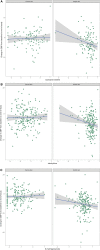Metabolomic Profiles Associated With Blood Pressure Reduction in Response to the DASH and DASH-Sodium Dietary Interventions
- PMID: 37161796
- PMCID: PMC10262995
- DOI: 10.1161/HYPERTENSIONAHA.123.20901
Metabolomic Profiles Associated With Blood Pressure Reduction in Response to the DASH and DASH-Sodium Dietary Interventions
Abstract
Background: The DASH (Dietary Approaches to Stop Hypertension) diets reduced blood pressure (BP) in the DASH and DASH-Sodium trials, but the underlying mechanisms are unclear. We identified metabolites associated with systolic BP or diastolic BP (DBP) changes induced by dietary interventions (DASH versus control arms) in 2 randomized controlled feeding studies-the DASH and DASH-Sodium trials.
Methods: Metabolomic profiling was conducted in serum and urine samples collected at the end of diet interventions: DASH (n=219) and DASH-Sodium (n=395). Using multivariable linear regression models, associations were examined between metabolites and change in systolic BP and DBP. Tested for interactions between diet interventions and metabolites were the following comparisons: (1) DASH versus control diets in the DASH trial (serum), (2) DASH high-sodium versus control high-sodium diets in the DASH-Sodium trial (urine), and (3) DASH low-sodium versus control high-sodium diets in the DASH-Sodium trial (urine).
Results: Sixty-five significant interactions were identified (DASH trial [serum], 12; DASH high sodium [urine], 35; DASH low sodium [urine], 18) between metabolites and systolic BP or DBP. In the DASH trial, serum tryptophan betaine was associated with reductions in DBP in participants consuming the DASH diets but not control diets (P interaction, 0.023). In the DASH-Sodium trial, urine levels of N-methylglutamate and proline derivatives (eg, stachydrine, 3-hydroxystachydrine, N-methylproline, and N-methylhydroxyproline) were associated with reductions in systolic BP or DBP in participants consuming the DASH diets but not control diets (P interaction, <0.05 for all tests).
Conclusions: We identified metabolites that were associated with BP lowering in response to dietary interventions.
Registration: URL: https://www.
Clinicaltrials: gov/ct2/show/NCT03403166; Unique identifier: NCT03403166 (DASH trial). URL: https://www.
Clinicaltrials: gov/ct2/show/NCT00000608; Unique identifier: NCT00000608 (DASH-Sodium trial).
Keywords: blood pressure; dietary approaches to stop hypertension; hypertension; metabolic networks and pathways; metabolomics.
Conflict of interest statement
Figures




Similar articles
-
Time Course of Change in Blood Pressure From Sodium Reduction and the DASH Diet.Hypertension. 2017 Nov;70(5):923-929. doi: 10.1161/HYPERTENSIONAHA.117.10017. Hypertension. 2017. PMID: 28993451 Free PMC article. Clinical Trial.
-
Urine Metabolites Associated with the Dietary Approaches to Stop Hypertension (DASH) Diet: Results from the DASH-Sodium Trial.Mol Nutr Food Res. 2021 Feb;65(3):e2000695. doi: 10.1002/mnfr.202000695. Epub 2020 Dec 28. Mol Nutr Food Res. 2021. PMID: 33300290 Free PMC article. Clinical Trial.
-
Serum untargeted metabolomic profile of the Dietary Approaches to Stop Hypertension (DASH) dietary pattern.Am J Clin Nutr. 2018 Aug 1;108(2):243-255. doi: 10.1093/ajcn/nqy099. Am J Clin Nutr. 2018. PMID: 29917038 Free PMC article. Clinical Trial.
-
Dietary Approaches to Stop Hypertension (DASH) Diet and Blood Pressure Reduction in Adults with and without Hypertension: A Systematic Review and Meta-Analysis of Randomized Controlled Trials.Adv Nutr. 2020 Sep 1;11(5):1150-1160. doi: 10.1093/advances/nmaa041. Adv Nutr. 2020. PMID: 32330233 Free PMC article.
-
Overview of salt restriction in the Dietary Approaches to Stop Hypertension (DASH) and the Mediterranean diet for blood pressure reduction.Rev Cardiovasc Med. 2022 Jan 19;23(1):36. doi: 10.31083/j.rcm2301036. Rev Cardiovasc Med. 2022. PMID: 35092228 Review.
Cited by
-
Clinical effectiveness of fecal microbial transplantation for metabolic syndrome: Advances in clinical efficacy and multi-omics research.Curr Res Microb Sci. 2025 Jun 5;9:100415. doi: 10.1016/j.crmicr.2025.100415. eCollection 2025. Curr Res Microb Sci. 2025. PMID: 40583967 Free PMC article. Review.
-
A Metabolome Wide Association Study of Fruit and Vegetable Consumption and Associations with Cardiovascular Disease Risk Factors: The International Study of Macro-/Micronutrients and Blood Pressure (INTERMAP) Study.J Nutr. 2025 Jan;155(1):122-131. doi: 10.1016/j.tjnut.2024.11.004. Epub 2024 Nov 12. J Nutr. 2025. PMID: 39536968 Free PMC article.
-
Plant Protein but Not Animal Protein Consumption Is Associated with Frailty through Plasma Metabolites.Nutrients. 2023 Sep 28;15(19):4193. doi: 10.3390/nu15194193. Nutrients. 2023. PMID: 37836476 Free PMC article.
-
Metabolite Profiles in Response to Dietary Interventions for Management of Blood Pressure: A Systematic Review.Curr Nutr Rep. 2025 Jun 20;14(1):82. doi: 10.1007/s13668-025-00676-7. Curr Nutr Rep. 2025. PMID: 40540135 Free PMC article. Review.
-
Nutrition and Hypertension Researches in 2023: focus on salt intake and blood pressure.Hypertens Res. 2025 Apr;48(4):1471-1476. doi: 10.1038/s41440-024-02089-5. Epub 2025 Jan 27. Hypertens Res. 2025. PMID: 39871003 Free PMC article. Review.
References
-
- Lichtenstein AH, Appel LJ, Vadiveloo M, Hu FB, Kris-Etherton PM, Rebholz CM, Sacks FM, Thorndike AN, Van Horn L, Wylie-Rosett J. 2021 dietary guidance to improve cardiovascular health: a scientific statement from the American Heart Association. Circulation. 2021;144:e472–e487. doi: 10.1161/CIR.0000000000001031 - PubMed
-
- US Department of Agriculture, US Department of Health and Human Services, Health and Human Services. Dietary Guidelines for Americans, 2020-2025 [Internet]. US Government Printing Office; 2020. https://www.dietaryguidelines.gov/
-
- Appel LJ, Moore TJ, Obarzanek E, Vollmer WM, Svetkey LP, Sacks FM, Bray GA, Vogt TM, Cutler JA, Windhauser MM, et al. . A clinical trial of the effects of dietary patterns on blood pressure. N Engl J Med. 1997;336:1117–1124. doi: 10.1056/nejm199704173361601 - PubMed
-
- Sacks FM, Svetkey LP, Vollmer WM, Appel LJ, Bray GA, Harsha D, Obarzanek E, Conlin PR, Miller ER, Simons-Morton DG, et al. ; DASH-Sodium Collaborative Research Group. Effects on blood pressure of reduced dietary sodium and the Dietary Approaches to Stop Hypertension (DASH) diet. N Engl J Med. 2001;344:3–10. doi: 10.1056/NEJM200101043440101 - PubMed
Publication types
MeSH terms
Substances
Associated data
Grants and funding
LinkOut - more resources
Full Text Sources
Medical

